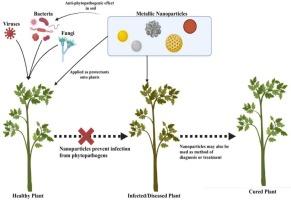Exploring the potential of metallic and metal oxide nanoparticles for reinforced disease management in agricultural systems: A comprehensive review
Q1 Environmental Science
Environmental Nanotechnology, Monitoring and Management
Pub Date : 2024-08-30
DOI:10.1016/j.enmm.2024.100998
引用次数: 0
Abstract
Metallic nanoparticles are regarded as one of the most versatile and environmentally beneficial nanocompounds, especially in agriculture. The anti-phytopathogenic properties of metallic and metal-based nanoparticles are the principal objective of this study. This article provides an analysis of the protection-based applications of nanoparticles comprising the following elements: silicon, chitosan, gold (Au), silver (Ag), platinum (Pt), copper (Cu), nickel (Ni), iron (Fe), zinc (Zn), titanium (Ti), and aluminium (Al), in addition to their metallic oxides and carriers. Furthermore, an examination of their manner of manufacturing using biological precursors, commonly referred to as “green synthesis,” and their impact on phytopathogens and parasites has been presented. We concluded that biosynthesized metallic nanoparticles have a diverse array of potential applications as disease control agents due to their superior antioxidant capacities, reduced phytotoxicity, and increased biocompatibility with plant systems in comparison to conventionally synthesized nanoparticles. Nanoparticles improve agricultural processes by increasing efficiency, lowering environmental impact, and addressing phytotoxicity problems. Material scientists and biologists must work together to refine metallic nanoparticles such as zinc, nickel, and copper for effective and environmentally friendly crop protection. Further investigation is warranted to ascertain the extent of these nanoparticles’ impact on commercial applications through concentration measurements and method of action analysis, notwithstanding these advantages. This research aims to bridge the knowledge gaps that exist between studies of various metals and offer a comprehensive overview of the latest developments in the field.

探索金属和金属氧化物纳米粒子在农业系统中加强病害管理的潜力:综述
金属纳米粒子被认为是用途最广、对环境最有益的纳米化合物之一,尤其是在农业领域。金属和金属基纳米粒子的抗植物病原体特性是本研究的主要目标。本文分析了由以下元素组成的纳米粒子的保护性应用:硅、壳聚糖、金(Au)、银(Ag)、铂(Pt)、铜(Cu)、镍(Ni)、铁(Fe)、锌(Zn)、钛(Ti)和铝(Al),以及它们的金属氧化物和载体。此外,我们还研究了利用生物前体(通常称为 "绿色合成")制造它们的方式,以及它们对植物病原体和寄生虫的影响。我们得出的结论是,与传统合成的纳米粒子相比,生物合成的金属纳米粒子具有更强的抗氧化能力、更低的植物毒性以及更高的植物系统生物相容性,因此具有作为病害控制剂的多种潜在应用。纳米粒子可以提高效率、降低对环境的影响并解决植物毒性问题,从而改善农业生产过程。材料科学家和生物学家必须共同努力,改进锌、镍和铜等金属纳米粒子,以实现有效和环保的作物保护。尽管这些纳米粒子具有上述优势,但仍需进一步调查,通过浓度测量和作用方法分析,确定其对商业应用的影响程度。本研究旨在弥补各种金属研究之间存在的知识差距,并全面概述该领域的最新进展。
本文章由计算机程序翻译,如有差异,请以英文原文为准。
求助全文
约1分钟内获得全文
求助全文
来源期刊

Environmental Nanotechnology, Monitoring and Management
Environmental Science-Water Science and Technology
CiteScore
13.00
自引率
0.00%
发文量
132
审稿时长
48 days
期刊介绍:
Environmental Nanotechnology, Monitoring and Management is a journal devoted to the publication of peer reviewed original research on environmental nanotechnologies, monitoring studies and management for water, soil , waste and human health samples. Critical review articles, short communications and scientific policy briefs are also welcome. The journal will include all environmental matrices except air. Nanomaterials were suggested as efficient cost-effective and environmental friendly alternative to existing treatment materials, from the standpoints of both resource conservation and environmental remediation. The journal aims to receive papers in the field of nanotechnology covering; Developments of new nanosorbents for: •Groundwater, drinking water and wastewater treatment •Remediation of contaminated sites •Assessment of novel nanotechnologies including sustainability and life cycle implications Monitoring and Management papers should cover the fields of: •Novel analytical methods applied to environmental and health samples •Fate and transport of pollutants in the environment •Case studies covering environmental monitoring and public health •Water and soil prevention and legislation •Industrial and hazardous waste- legislation, characterisation, management practices, minimization, treatment and disposal •Environmental management and remediation
 求助内容:
求助内容: 应助结果提醒方式:
应助结果提醒方式:


